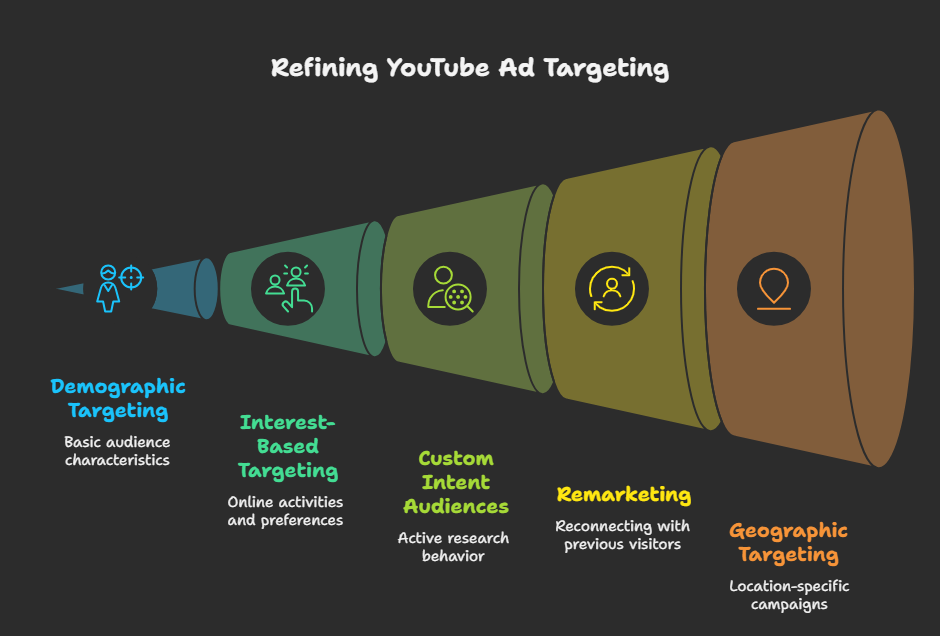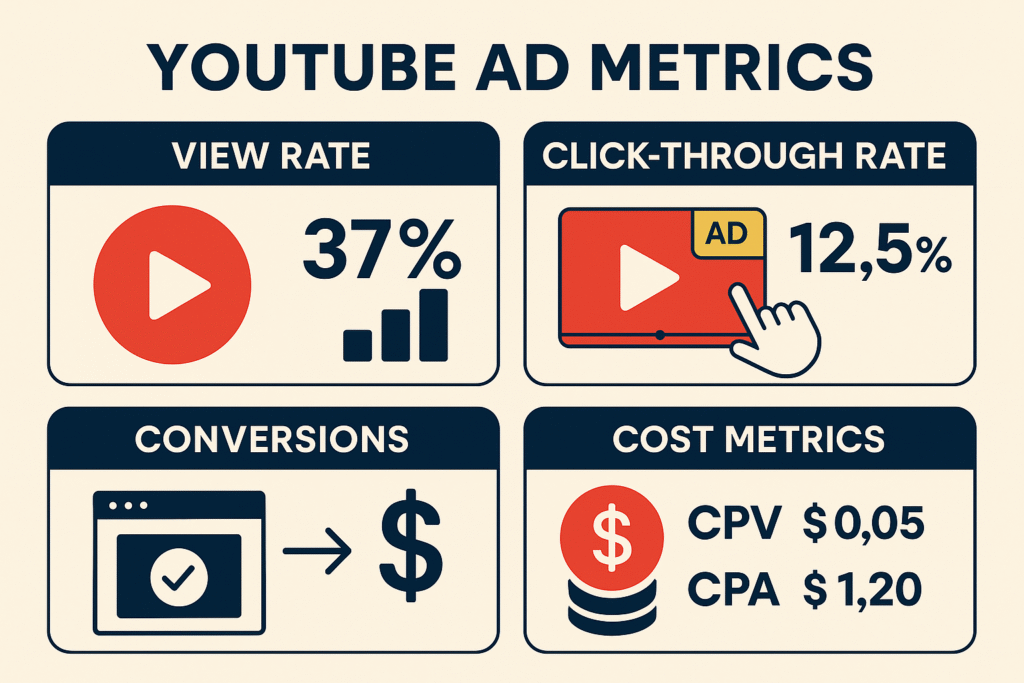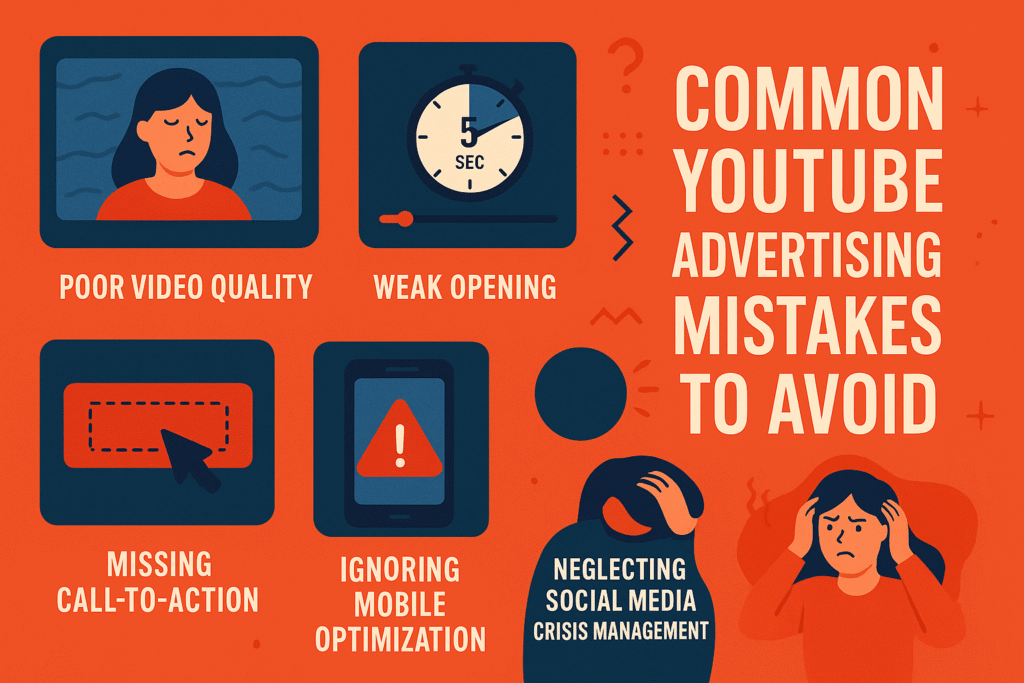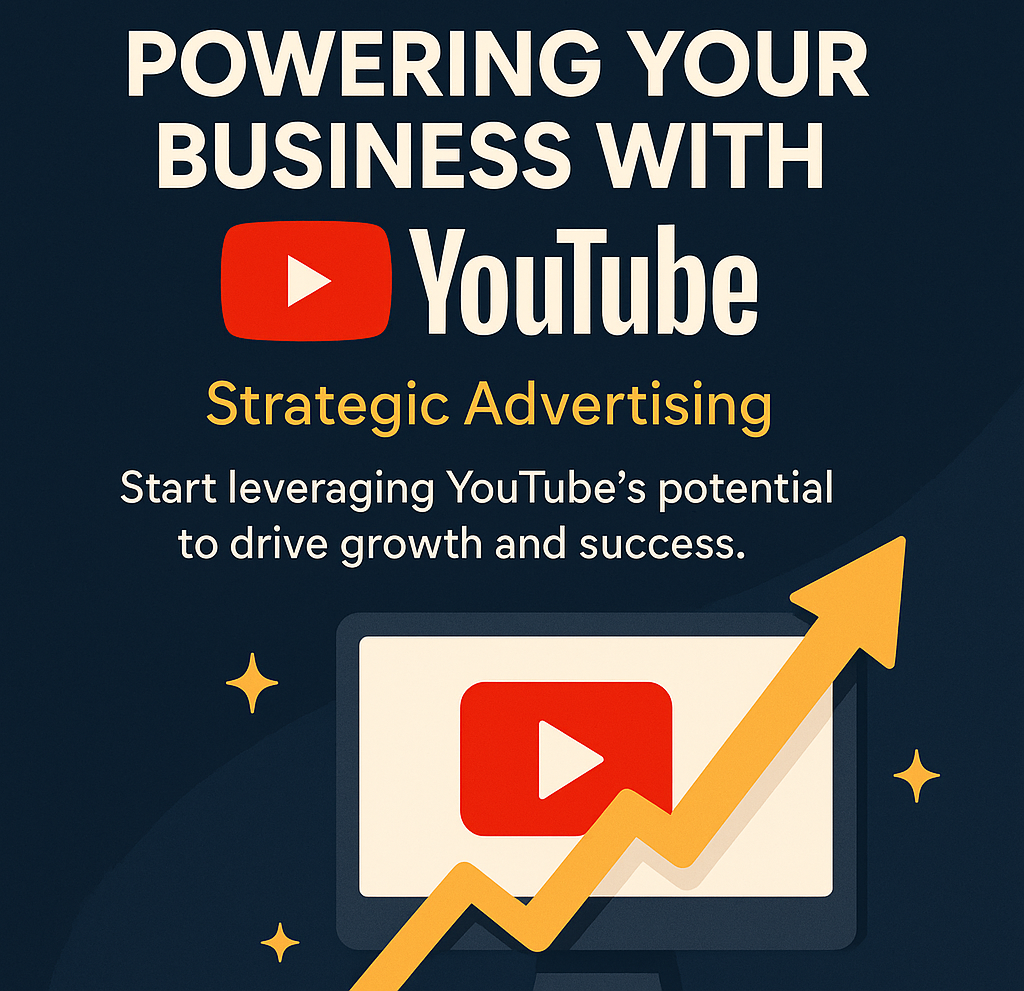Table of Contents
YouTube advertising has become the backbone of successful digital marketing campaigns. With over 2 billion monthly active users, the platform offers businesses unmatched opportunities to reach their target audience through compelling video content.
Many business owners struggle with creating video ads that actually convert viewers into customers. The challenge lies not just in producing quality content, but in understanding how YouTube’s advertising ecosystem works and what makes viewers take action.
Understanding YouTube Ads and Their Impact
YouTube ads are paid video advertisements that appear across the YouTube platform and Google’s partner sites. These promotional videos can appear before, during, or after other videos, in search results, or as standalone content recommendations.
The platform offers several ad formats designed for different marketing objectives. Skippable in-stream ads play before or during videos and allow viewers to skip after five seconds. Non-skippable ads ensure complete message delivery but must be 15 seconds or shorter. Discovery ads appear in search results and suggested video feeds, while bumper ads deliver quick six-second messages.
Smart businesses leverage YouTube advertising because it combines the power of visual storytelling with sophisticated targeting capabilities. The platform’s integration with Google’s advertising network means companies can reach users based on search history, interests, demographics, and online behavior patterns.
“Video is the future of content marketing. That is, if it’s not the here and now.” – Chris Trimble, CMO
Modern consumers spend significant time watching online videos, making YouTube an essential channel for brand awareness and customer acquisition. Companies that master YouTube advertising often see improved brand recognition, increased website traffic, and higher conversion rates compared to traditional advertising methods.
The Role of YouTube Advertising in Modern Ad Campaigns
Video content has fundamentally changed how businesses communicate with their audience. YouTube advertising serves as a crucial component in integrated marketing campaigns, offering unique advantages that complement other digital marketing efforts.
Unlike static advertisements, video ads tell complete stories and demonstrate products in action. This format allows businesses to showcase their value proposition more effectively than text-based ads. The visual and auditory elements work together to create emotional connections with potential customers.
YouTube’s massive reach makes it particularly valuable for businesses targeting younger demographics. The platform attracts users across all age groups, but millennials and Gen Z spend considerable time consuming video content. Companies can tap into this engaged audience through well-crafted advertising campaigns.
The platform’s analytics provide detailed insights into viewer behavior, helping businesses understand which content resonates with their audience. This data-driven approach enables continuous improvement of advertising strategies and better return on investment.
Successful integration of multimedia marketing principles enhances YouTube advertising effectiveness. Companies that understand how different media types work together create more compelling campaigns that drive stronger results.
Getting Started with YouTube Advertising
Setting up YouTube advertising begins with creating a Google Ads account and linking it to a YouTube channel. This connection allows businesses to manage their video campaigns alongside other Google advertising efforts, creating a unified marketing approach.
The initial setup process involves defining campaign objectives, such as brand awareness, website traffic, or lead generation. YouTube’s campaign types align with specific business goals, making it easier to choose the right advertising format for desired outcomes.
Budget allocation requires careful consideration of both daily spending limits and overall campaign duration. New advertisers often benefit from starting with smaller budgets to test different approaches before scaling successful campaigns. The platform’s bidding options include cost-per-view, cost-per-click, and cost-per-thousand-impressions models.
Audience targeting represents one of YouTube advertising’s most powerful features. Businesses can define their ideal customers based on demographics, interests, behaviors, and even specific YouTube channels they watch. Custom audiences allow for remarketing to website visitors or existing customer lists.
Understanding AI-powered campaign success analytics helps businesses make data-driven decisions about their YouTube advertising investments. These tools provide insights that traditional analytics might miss.
Why YouTube Ads Outperform Traditional Advertising
| Traditional Advertising | YouTube Advertising |
|---|---|
| Limited targeting options | Precise audience targeting |
| Difficult to measure ROI | Detailed analytics and tracking |
| High minimum investment | Flexible budget options |
| One-way communication | Interactive engagement |
YouTube’s global reach enables businesses to expand into new markets without the complexity of traditional international advertising. Companies can test different regions with minimal investment and scale successful campaigns based on performance data.
Creating Video Content for YouTube Ads
Effective YouTube ads capture attention within the first few seconds and maintain viewer interest throughout the entire message. The opening moments determine whether viewers will continue watching or skip to their intended content.
Strong visual elements combined with clear audio create professional-looking advertisements that reflect well on business brands. High-quality production values don’t always require expensive equipment, but they do demand attention to detail in lighting, sound, and editing.
Storytelling techniques help create emotional connections with viewers. Successful YouTube ads often follow narrative structures that introduce problems, present solutions, and demonstrate positive outcomes. This approach feels more natural than direct sales pitches and tends to generate better engagement rates.
The importance of sound design cannot be overstated in video advertising. Quality audio enhances the viewing experience and ensures messages are clearly communicated, even when viewers aren’t actively watching the screen.
Call-to-action elements guide viewers toward desired behaviors. Clear instructions about next steps, whether visiting a website, subscribing to a channel, or making a purchase, significantly improve campaign effectiveness. These calls-to-action should feel natural within the video’s context rather than forced or interrupting.
Maintaining brand consistent visuals across all YouTube ads helps build recognition and trust with audiences. Consistent color schemes, fonts, and imagery create professional appearances that reinforce brand identity.
Enhancing YouTube Ad Targeting for Maximum Reach

Effective targeting ensures YouTube ads reach the most relevant audiences for business offerings. The platform provides numerous targeting options that can be combined to create highly specific audience segments.
Demographic targeting covers basic characteristics like age, gender, parental status, and household income. While useful as starting points, demographic data alone rarely creates optimal targeting strategies. Combining demographics with interest and behavior data produces better results.
Interest-based targeting reaches users based on their online activities and preferences. YouTube analyzes viewing history, search patterns, and engagement behaviors to categorize users into interest groups. This approach helps businesses reach people genuinely interested in their products or services.
Custom intent audiences target users actively researching specific products or services. These audiences are created based on recent search activity and website visits, making them highly valuable for businesses looking to capture users ready to make purchasing decisions.
Remarketing capabilities allow businesses to reconnect with previous website visitors or YouTube channel subscribers. These warm audiences often convert at higher rates because they already have some familiarity with the brand.
Geographic targeting enables location-specific campaigns, which is particularly valuable for local businesses or companies testing new markets. Time-based targeting can optimize ad delivery for when target audiences are most active online.
Understanding customer data platforms enhances targeting accuracy by providing deeper insights into customer behaviors and preferences.
Measuring YouTube Advertising Success

YouTube advertising success extends beyond simple view counts to include meaningful business metrics. Understanding which metrics matter most for specific campaign objectives helps businesses allocate resources effectively and improve performance over time.
View rate measures the percentage of impressions that result in video views. Higher view rates indicate compelling thumbnails and ad copy that entice users to watch. Low view rates might suggest targeting issues or weak creative elements that need improvement.
Click-through rates show how many viewers take action after watching ads. This metric particularly matters for campaigns focused on driving website traffic or generating leads. Strong calls-to-action and relevant landing pages typically improve click-through performance.
Conversion tracking connects YouTube ad views to actual business outcomes like sales, sign-ups, or downloads. Setting up proper conversion tracking requires implementing tracking codes on websites but provides invaluable insights into advertising return on investment.
Cost metrics help evaluate campaign efficiency. Cost-per-view shows how much businesses pay for each video view, while cost-per-click reveals the expense of driving traffic to websites. Cost-per-acquisition measures the investment required to generate customers or leads.
| Metric | What It Measures | Why It Matters |
|---|---|---|
| View Rate | % of impressions that become views | Indicates ad appeal and relevance |
| CTR | % of viewers who click | Shows call-to-action effectiveness |
| Conversion Rate | % of clicks that convert | Measures actual business impact |
| ROAS | Revenue per advertising dollar | Determines campaign profitability |
Audience retention graphs reveal when viewers stop watching ads. This data helps identify weak points in video content and opportunities for improvement. High retention rates throughout entire videos suggest strong content that maintains viewer interest.
Utilizing Google Analytics 4 tips enhances measurement capabilities by providing deeper insights into user behavior after they interact with YouTube ads.
YouTube Advertising Success Stories and Best Practices
Learning from successful YouTube advertising campaigns provides valuable insights for businesses developing their own strategies. Real-world examples demonstrate how different approaches work across various industries and campaign objectives.
Dollar Shave Club’s viral YouTube ad campaign generated millions of views and transformed a startup into a major brand. Their success came from combining humor with clear value propositions, creating memorable content that viewers actively shared. The campaign’s authenticity resonated with audiences tired of traditional razor advertisements.
Old Spice revitalized their brand through creative YouTube advertising that targeted younger demographics. Their campaign featured unexpected humor and interactive elements that encouraged viewer participation. The approach successfully repositioned an older brand for modern consumers.
Blendtec’s “Will It Blend?” series demonstrated product capabilities through entertaining content. Rather than traditional product demonstrations, they created viral videos showing their blenders destroying various objects. This approach generated massive organic reach while showcasing product durability.
Small businesses have also achieved remarkable success through strategic YouTube advertising. Local restaurants use video tours and customer testimonials to attract nearby diners. Service-based businesses create educational content that demonstrates expertise while subtly promoting their offerings.
The key patterns in successful campaigns include authentic storytelling, clear value propositions, and strong calls-to-action. Companies that focus on solving customer problems rather than just promoting products tend to achieve better engagement and conversion rates.
Incorporating storyboarding techniques helps businesses plan compelling narratives that resonate with target audiences and drive desired actions.
Common YouTube Advertising Mistakes to Avoid

Many businesses make preventable mistakes that limit their YouTube advertising success. Understanding these common pitfalls helps companies avoid wasting budget and missing opportunities for growth.
Poor video quality reflects negatively on brand perception and reduces viewer engagement. While expensive equipment isn’t always necessary, businesses should ensure clear audio, good lighting, and stable footage. Technical issues distract from marketing messages and can damage credibility.
Weak opening sequences cause viewers to skip ads before hearing the main message. The first five seconds must immediately capture attention and provide compelling reasons to continue watching. Generic openings or slow starts typically result in high skip rates and poor campaign performance.
Irrelevant targeting wastes advertising budget on audiences unlikely to convert. Businesses sometimes cast too wide a net hoping to reach more people, but this approach often leads to higher costs and lower conversion rates. Focused targeting on qualified prospects typically produces better results.
Missing or weak calls-to-action leave viewers uncertain about next steps. Clear instructions about desired actions, whether visiting websites, making purchases, or subscribing to channels, significantly improve campaign effectiveness. The call-to-action should align with campaign objectives and feel natural within the video content.
Ignoring mobile optimization overlooks a significant portion of YouTube’s audience. Many viewers watch videos on smartphones and tablets, so ads must work well on smaller screens. Text should be readable, and important visual elements should remain clear when viewed on mobile devices.
Neglecting social media crisis management principles can lead to problems when YouTube ads generate unexpected negative responses or controversial discussions.
Conclusion
YouTube advertising represents one of the most powerful tools available for modern businesses seeking to reach engaged audiences through compelling video content. Success requires understanding the platform’s unique features, creating high-quality content that resonates with target audiences, and continuously optimizing campaigns based on performance data.
The strategies outlined in this article provide a foundation for businesses ready to leverage YouTube’s advertising capabilities. From basic campaign setup to advanced optimization techniques, these approaches help companies maximize their return on investment while building stronger relationships with potential customers.
The future of YouTube advertising looks increasingly sophisticated, with artificial intelligence, interactive features, and improved targeting capabilities creating new opportunities for businesses willing to embrace these advances. Companies that start building their YouTube advertising expertise today will be well-positioned to capitalize on these emerging trends.
Ready to transform your business through strategic YouTube advertising? Start by analyzing your target audience, creating compelling video content, and implementing the optimization strategies discussed in this article. Remember that successful YouTube advertising is an ongoing process of testing, learning, and refining your approach based on real performance data.
Frequently Asked Questions
How much should businesses budget for YouTube advertising?
YouTube advertising budgets vary significantly based on business size, industry, and objectives. Small businesses can start with as little as $10-50 per day to test campaigns, while larger companies might invest thousands monthly. The key is starting with manageable amounts and scaling based on performance results.
What video length works best for YouTube ads?
Optimal video length depends on ad format and campaign objectives. Skippable ads perform well at 30-60 seconds, providing enough time to deliver complete messages while respecting viewer attention spans. Non-skippable ads must be 15 seconds or shorter, requiring more concise messaging.
How long does it take to see results from YouTube advertising?
Initial campaign data appears within 24-48 hours, but meaningful performance trends typically emerge after 1-2 weeks of consistent running. Optimization improvements may take additional time to implement and measure, so businesses should plan for at least 30 days to evaluate campaign effectiveness properly.
Can small businesses compete with large companies on YouTube?
Small businesses can absolutely compete effectively on YouTube through creative content, targeted messaging, and strategic budget allocation. Success depends more on understanding target audiences and creating relevant content than on having large advertising budgets.
What makes YouTube ads different from other video advertising platforms?
YouTube’s integration with Google’s advertising network provides superior targeting capabilities and measurement tools. The platform’s massive user base and sophisticated analytics make it particularly effective for businesses seeking measurable results from video advertising investments.
